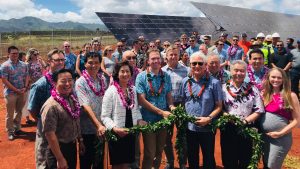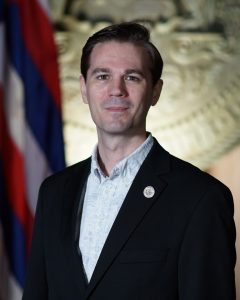Setting Hawai‘i on a path to energy transformation
Posted on Apr 27, 2022 in Capitol Connection, Featured, MainElectricity is something we all take for granted until the power goes out. But for Governor Ige and others, the vision has been much bigger — for us in Hawai‘i, the nation and the world. “The governor is focused on solving real problems now with deeper structural changes,” said Scott Glenn, director of the Hawai‘i State Energy Office (HSEO). “We’re looking not only for the short-term fixes, but also long-term transformational benefits.”
The path to a clean energy future starts with making personal choices, whether it’s solar panels, energy-efficient appliances or adopting cleaner forms of transportation like walking, taking the bus, using electric cars or more fuel-efficient vehicles. But it also depends on government making tough choices that could make or break our clean energy future. “In 2015, the governor came out strongly against LNG (liquefied natural gas) because he thought the short-term benefits came at the cost of our long-term future,” Glenn explained. “He also said no to the out-of-state electric company NextEra because he wanted to ensure local decision-making committed to renewable energy.”
Glenn said the march toward a greener future has been marked by many more milestones in Hawai‘i. That includes the governor saying “yes” to the Paris climate accord, new renewable source standards for electric utilities, closing the last coal plant in the state this fall, committing to a net-negative carbon emissions goal, and being the first state in the nation to set a goal of 100% clean energy electrical generation by 2045. Since Governor Ige took office, Hawai‘i has doubled its renewable energy for electricity from 20% in 2014 to 40% today. As a state, we’re 8 years ahead of our 2030 goal, Glenn said.
According to national surveys, our islands have the most rooftop solar and the second-most electric cars per capita in the country. The state has also committed to more nature-based solutions, such as planting 100 million trees for the global 1 Trillion Tree initiative, to capture more carbon than we emit. “We’re also leading by example by converting our state fleets to electric cars by 2035 and laying out renewable energy projects needed to retire our oil-fired plants,” said Glenn. The Ige administration has also implemented energy-saving measures at state airports, highways and harbors as well as in public schools and the UH system.
“Putting clean energy options within reach of working families is the key to making progress,” said the governor. President Biden’s new infrastructure plan makes more funding available so Hawai‘i can increase EV charging stations across communities to make it easier to drive an electric vehicle. “The infrastructure funds should help us get better rebates than we have today and buy more energy efficient appliances to lower our electricity bills,” said Glenn. “We need to get to a place where we can get off oil, to make Hawai‘i more energy self-sufficient and costs more predictable. That’s what the governor has said all along,” he continued. “That’s what will create a more resilient economy for all of us, where we don’t depend on other countries and the mainland U.S. to supply most of our energy needs.”


